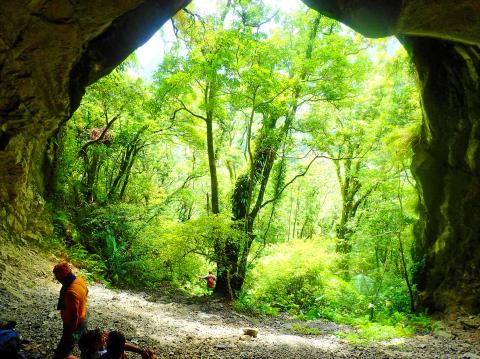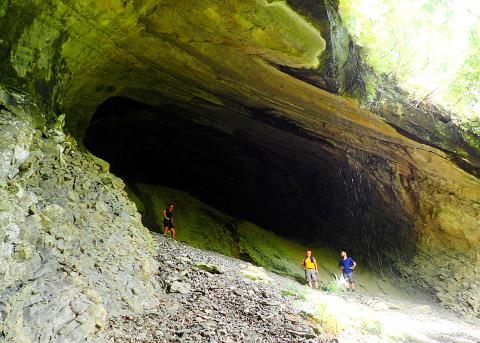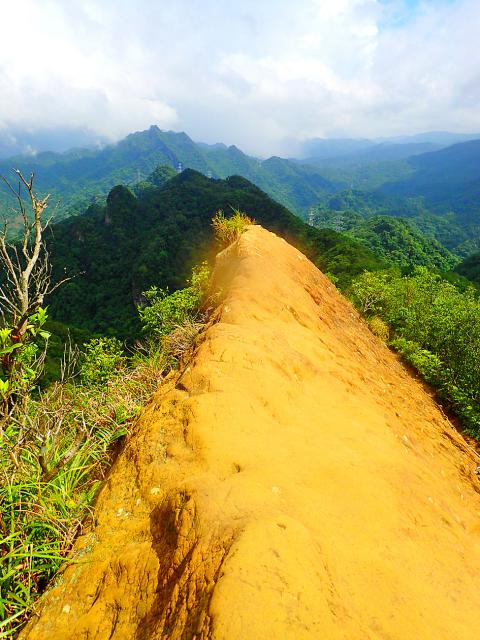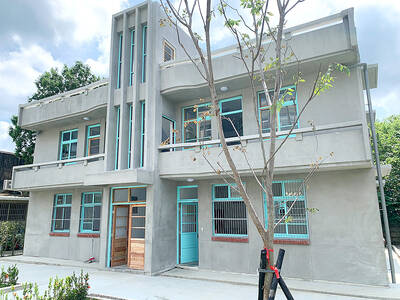Huangdidian (皇帝殿) has been one of the classic hikes of New Taipei City area for decades now. Even when I first hiked there back in the mid-90s, it couldn’t by any stretch of the imagination be described as “off the beaten track.” I got to enjoy it a couple of times before the local authorities turned most of the trails leading up to the ridge into wide paths of stone steps, which are great for families in dry weather, but treacherously slippery when wet.
Once those horrible steps are left behind, the ridge trails are so much fun that for many years I was never able to tear myself away from the main area and explore further. For those unfortunates who didn’t know Huangdidian over a decade ago, most ledges were a lot narrower. In an attempt to make the hike less “risky,” the rock has been chiseled away to make the ledge wider in many places. The footholds cut into the rockfaces are also much bigger than before. But even today, the knife-edge ridges are still a fun adrenaline rush.
Most first-timers to Huangdidian are happy sticking to the popular tourist route, which connects the West Peak (東峰) and East Peak (東峰). On subsequent visits, try leaving the weekend crowds behind and explore the less popular trails a little further east along the ridge, (they haven’t yet been “improved,”) and are still fun and challenging.

Photo: Richard Saunders
Perhaps the most compelling reason to go this way, though, is Huangdidian bat cave (皇帝殿蝙蝠洞), the largest cave mouth in the Taipei and New Taipei City area. It’s a short but tough side trip from the usual circuit, and certainly not for inexperienced hikers, nor one to be attempted alone.
The quickest way to the cave is to take the wide stone steps from the car park at Siaocukeng (小粗坑) trailhead and go up to the East Peak — do not take the set on the left, which go up to Tianwang cave temple (天王廟)and the West Peak. The steps wind up through the woods, and eventually peter out just a few meters below the summit of the ridge. Here, look out for a rough, indistinct dirt trail branching off to the right, which soon climbs very steeply.
Keep straight on at a junction, and the trail soon follows an overgrown knife-edge ridge of rock. Shortly, a tin sign pointing straight down the wooded precipice to the right (with fixed ropes the whole way) shows the way down to the bat cave.

Photo: Richard Saunders
At the bottom swing right, following a natural, horizontal crack in the cliff face. There’s no solid ground at all in places, the precipice falling away below, but the exposed tree roots are strong enough to take the feet of an occasional hiking group. Finally, scramble up a very steep scree of loose rocks to the cave above — take care while climbing not to send any rocks hurtling down on others below.
CAVING IN
It’s only from inside that the cave’s size can be appreciated, but don’t hang around too long — the cave roof is unstable and there’s a risk of rock falls. And yes, there are a few bats inside.

Photo: Richard Saunders
Head back to Huangdidian East Peak (563m), which offers a fantastic view. Follow the base of the bare blade of sandstone at its summit, and beyond it the trail soon descends along the sharp spine of rock. This short stretch after the East Peak is one of the finest moments along the entire ridge, with inspiring views in clear weather.
To get down you have a choice of two routes. Either retrace your steps back to the East Peak and follow the popular route along the knife-edges and down one of three stone-step paths back to Siaocukeng car park, or (for a more interesting, much less crowded route) continue east, past the pointed little finger of rock called Siaobajian (小霸尖), then descend, via another stone step path, to little Yongding village (永定) on Provincial Route 106, the road connecting Muzha to Ruifang.
Turn left through the village to a bus stop for bus 795, which goes to Muzha MRT station. Next to it a small shop sells ice-cold drinks — a very welcome end to a strenuous four to five hour hike.
IF YOU GO
◆ Huangdidian is best reached by taking the ominously-numbered bus 666 from Jingmei MRT station, which leaves from near exit 2. From the MRT exit, walk down the street towards the wooded hill for another hundred meters. Cross the road and beside a small park is the bus stop.
◆ To complicate matters, bus 666 has three routes, only one of which passes close to the trailhead of Huangdidian, so check times in advance and aim to take one of the infrequent buses that stop at Huangdidian bus stop (皇帝殿站). Otherwise take any bus 666 service, get off at Shiding bus stop (石碇站) and follow the road (Provincial Route 106) ahead, beside the stream (soon crossing it) for about 1.5km to Huangdidian bus stop.
◆ Now take the lane on the left beside the bus stop, cross the stream and pass a temple. At the junction follow either branch (the two roads rejoin a little further up) for another kilometer to the car park and trailhead at Siaocukeng.

June 2 to June 8 Taiwan’s woodcutters believe that if they see even one speck of red in their cooked rice, no matter how small, an accident is going to happen. Peng Chin-tian (彭錦田) swears that this has proven to be true at every stop during his decades-long career in the logging industry. Along with mining, timber harvesting was once considered the most dangerous profession in Taiwan. Not only were mishaps common during all stages of processing, it was difficult to transport the injured to get medical treatment. Many died during the arduous journey. Peng recounts some of his accidents in

“Why does Taiwan identity decline?”a group of researchers lead by University of Nevada political scientist Austin Wang (王宏恩) asked in a recent paper. After all, it is not difficult to explain the rise in Taiwanese identity after the early 1990s. But no model predicted its decline during the 2016-2018 period, they say. After testing various alternative explanations, Wang et al argue that the fall-off in Taiwanese identity during that period is related to voter hedging based on the performance of the Democratic Progressive Party (DPP). Since the DPP is perceived as the guardian of Taiwan identity, when it performs well,

The Taiwan People’s Party (TPP) on May 18 held a rally in Taichung to mark the anniversary of President William Lai’s (賴清德) inauguration on May 20. The title of the rally could be loosely translated to “May 18 recall fraudulent goods” (518退貨ㄌㄨㄚˋ!). Unlike in English, where the terms are the same, “recall” (退貨) in this context refers to product recalls due to damaged, defective or fraudulent merchandise, not the political recalls (罷免) currently dominating the headlines. I attended the rally to determine if the impression was correct that the TPP under party Chairman Huang Kuo-Chang (黃國昌) had little of a

At Computex 2025, Nvidia CEO Jensen Huang (黃仁勳) urged the government to subsidize AI. “All schools in Taiwan must integrate AI into their curricula,” he declared. A few months earlier, he said, “If I were a student today, I’d immediately start using tools like ChatGPT, Gemini Pro and Grok to learn, write and accelerate my thinking.” Huang sees the AI-bullet train leaving the station. And as one of its drivers, he’s worried about youth not getting on board — bad for their careers, and bad for his workforce. As a semiconductor supply-chain powerhouse and AI hub wannabe, Taiwan is seeing